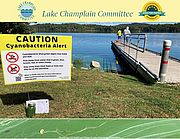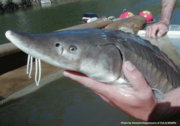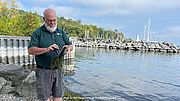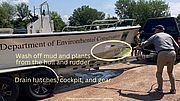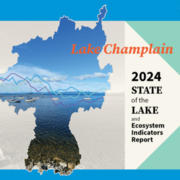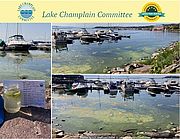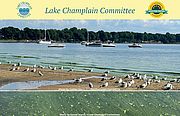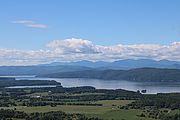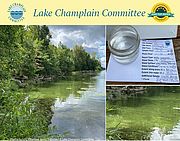The number of monitoring reports received for Lake Champlain fell below 100 for the first time this year during week 15 and we only received 16 reports from inland VT waterways as more volunteers and state and municipal seasonal staff left lakeside posts. Calm, dry, and relatively warm weather helped stimulate or sustain some significant blooms in Lake Champlain’s Main Lake North and Inland Sea and Malletts Bay had bloom activity as well. Read...
News from Selected Month
Aquatic plants in Lake Champlain will be dying back soon, but their blooms provide additional color to the vibrant autumn landscape. How did aquatic plants in the lake get there, and what helps make them successful away from land? We dig into the origin of plants, their journey from water to land and back again, and some specific adaptations of plants found in the Lake Champlain basin. Read...
Aquatic plants in Lake Champlain will be dying back soon, but their blooms provide additional color to the vibrant autumn landscape. How did aquatic plants in the lake get there, and what helps make them successful away from land? We dig into the origin of plants, their journey from water to land and back again, and some specific adaptations of plants found in the Lake Champlain basin.
Lake sturgeon are fish with a lot of superlatives. They have been on Earth longer than any flowering plant, can grow to the standing height of an adult man, and live to be supercentenarians in the right conditions a complicated relationship with people as it was Nearly driven to extinction and currently designated as endangered in Vermont and threatened in New York, lake sturgeon have complicated relationships with people. Read on to learn about their storied evolutionary history, “vintage” features, and how they got to the precarious state they’re in now. Read...
Aquatic invasive species (AIS) are among the major challenges facing Lake Champlain—they reduce biodiversity by outcompeting native species and disrupting ecological processes, and they can proliferate to impact water quality and recreation. LCC launched a volunteer community science initiative—the Champlain Aquatic invasive Monitoring Program (CHAMP)—to train folks how to identify and survey for key AIS in Lake Champlain. We still need volunteers to survey before the snow flies—you can sign up on our website and we’ll schedule additional trainings in your area. Read on to learn more about the program and stories from the field. Read...
Humans are the main conveyors of most aquatic invasive species, moving them from one body of water to another. Many of these troublesome plants and animals can be unintentionally transported on fishing gear, boating equipment, or even tiny amounts of water left in a watercraft. The simplest and most effective way to prevent the spread of aquatic invasives is to ensure that your vessel and all your equipment are cleaned, drained, and dried.
In June 2024 the Lake Champlain Basin Program -- the entity that coordinates and helps fund implementation of the Lake Champlain restoration and management plan in partnership with New York, Vermont, and Quebec government agencies – released its 2024 State of the Lake Report. The 36-page document provides an update on how Lake Champlain is faring according to four goals of clean water, healthy ecosystems, informed and involved public, and thriving communities. It includes a “scorecard” showing data trends on phosphorus, cyanobacteria blooms, and the introduction of new invasive species and uses easy-to-understand graphics and maps to illustrate complex issues. Read on for a brief tour of the contents and some take-aways. Read...
The Lake Champlain basin is full of stories that educators can use to teach all subjects, engage students in learning about their community, and integrate content, service, and a sense of belonging to their home watershed. To delve into these stories with teachers, the Lake Champlain Committee and our partners in the Champlain Basin Education Initiative (CBEI) hosted a course called Watershed for Every Classroom (WEC). The place-based educational program in the Lake Champlain watershed is part professional development and part summer camp for teachers. Read...
Cyanobacteria naturally occurs in lakes and have existed on earth for millions of years. Under the right conditions they form large accumulations referred to as blooms. Some types produce toxins which release into the water especially when cyanobacteria die and break down. Not all cyanobacteria blooms are toxic, but since there is no way to tell if toxins are present without laboratory tests, it is always safest to avoid blooms and adhere to beach closures—when in doubt, stay out. Read...
Blooms were observed daily during week 14 of monitoring and dominated the reports received on 9/15 and 9/20/24. A third of the reports over the seven-day period were of blooms reinforcing the importance of monitoring through much of fall and checking water conditions carefully before recreating. Read...
Hot weather at the end of week 13 helped fuel more blooms on Lake Champlain and inland waterways. When reviewing the stats for this week keep in mind that we have fewer monitors reporting this time of year, so coverage is less comprehensive. Case in point, we only received one report from St. Albans Bay but there were likely more blooms in that area during the week. Read...
Lake Champlain currently has 51 known non-native and invasive species with many more approaching—the Hudson River has over twice as many and the Great Lakes host nearly four times more. AIS pose a significant threat to ecosystem health. Early detection is key to controlling new populations before they become established—and you can help by becoming an LCC CHAMP community science volunteer! Click to learn more and sign up.
After CLF, LCC and VNRC’s petition, EPA says state of Vermont must revamp agricultural regulation. Read...
In a letter issued today to the VT Agency of Natural Resources the US Environmental Protection Agency (EPA) says Vermont falls short on Clean Water Act enforcement. The letter comes almost two and a half years after LCC, the Conservation Law Foundation (CLF), and the Vermont Natural Resources Council filed a petition asking EPA to thoroughly investigate how the state applies the Clean Water Act on farms. The issue arose from the Vermont’s Agency of Natural Resources and Agency of Agriculture both overseeing clean water regulations for farms. EPA found that Vermont does not do enough to regulate concentrated animal feeding operations – farms that keep a large number of animals confined to a small, densely populated space. Read...
Reporting dropped off dramatically during week 12 as we had fewer blooms, and many municipal and state personnel who monitor beaches left seasonal posts. Reminder that while week 12 had a fairly low incidence of blooms compared to recent weeks it is still peak bloom season and cyanobacteria can show up in any waterway. (We are seeing a bloom response to the warmer temperatures in week 13.) Read...

